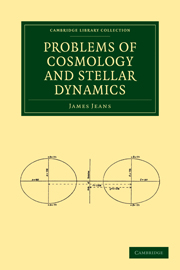Book contents
- Frontmatter
- Preface
- Contents
- I Introductory Chapter
- II General Dynamical Principles
- III Ellipsoidal Configurations of Equilibrium
- IV The Gravitational Potential of a Distorted Ellipsoid
- V Pear-shaped Configurations of Equilibrium
- VI Motion when there are no Stable Configurations of Equilibrium
- VII The Motion of Compressible and Non-homogeneous Masses
- VIII The Evolution of Gaseous Masses
- IX The Evolution of Rotating Nebulae
- X The Evolution of Star-Clusters
- XI The Evolution of Binary and Multiple Stars
- XII The Origin and Evolution of the Solar System
- Index
- Plate section
IX - The Evolution of Rotating Nebulae
Published online by Cambridge University Press: 05 October 2010
- Frontmatter
- Preface
- Contents
- I Introductory Chapter
- II General Dynamical Principles
- III Ellipsoidal Configurations of Equilibrium
- IV The Gravitational Potential of a Distorted Ellipsoid
- V Pear-shaped Configurations of Equilibrium
- VI Motion when there are no Stable Configurations of Equilibrium
- VII The Motion of Compressible and Non-homogeneous Masses
- VIII The Evolution of Gaseous Masses
- IX The Evolution of Rotating Nebulae
- X The Evolution of Star-Clusters
- XI The Evolution of Binary and Multiple Stars
- XII The Origin and Evolution of the Solar System
- Index
- Plate section
Summary
In the last chapter we examined the sequence of changes which would occur in a mass of gas left to its own gravitation at rest in space. We found that matter once in existence would either disperse into space or contract continually. Masses which disperse into space would have but a transitory existence; the permanent bodies in the heavens must be supposed to be contracting.
We accordingly think of the permanent astronomical bodies as beginning existence in a state of extreme rarity. If one such mass existed alone in the universe, it would tend to assume a spherical form if devoid of rotation, or a spheroidal or pseudo-spheroidal form if endowed with a small amount of rotation. Observation, however, does not encourage the view that the whole universe originated out of a single mass of gas; we shall find it more profitable to think of a number of separate and detached nebular masses as forming the earliest stage in the process of cosmic evolution.
Whether these masses ought to be thought of as being originally endowed with motion, either of translation or of rotation, we do not know. In any case they must in time be set into motion by their mutual gravitational attractions.
- Type
- Chapter
- Information
- Problems of Cosmology and Stellar Dynamics , pp. 203 - 219Publisher: Cambridge University PressPrint publication year: 2009First published in: 1919

